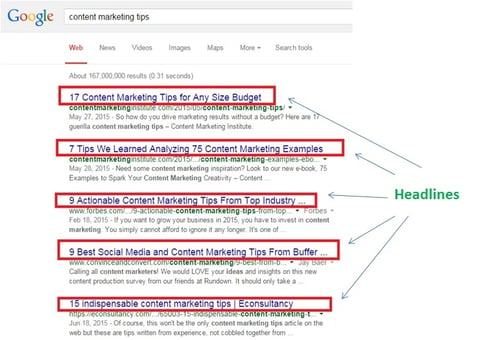Content, content, content—we’ve been focusing on it for some time, ever since Bill Gates coined “Content is King.” (Yeah, that was 1996!!)
Our CEO Brandon Heagle wrote his digital marketing predictions for 2015 in which he hailed content not merely as king, but as emperor—as the “Kublai Khan of the digital domain”. If content is the emperor, your headlines are the global ambassadors, traveling near and far, attracting new support and stirring up minions.
Perhaps that analogy is a stretch, but you get my point—headlines bring in the bread, the caviar, the black truffle mushrooms. No matter how great your content is, if people aren’t drawn in by the headline, you will not see the return you were hoping for. In this post I’ll share some tips for writing killer headlines, and discuss some basic do’s and don’ts.
What’s My Objective?
Every content marketer will tell you that it’s extremely important to plan. Yes, you must be producing content at a steady rate to feed the marketing machine. But always have an objective as part of a larger strategy. Before thinking about your headline, take a moment to think about what this content is supposed to do for you. Some examples include:
- Entertainment posts: fun content that draws users to your site. Examples of this would be quizzes and every listicle on the cutest cat videos ever.
- Short, easily digestible content: build brand awareness
- Practical, informational posts: generate leads by provide some useful information to your reader, prompting him/her to sign up for more useful information later.
- Evergreen content: more comprehensive, long-form content (such as guides), that attracts deeper, longer engagement and builds brand loyalty.
In the long run, your content should serve the business goals of your brand, including attracting leads and converting people, so make sure you understand the role your content has in your overall marketing strategy.
First Step: Do Your Keyword Research
Ultimately, headlines should be the beacon that attracts searchers to your content—they should answer a question or peak an interest. Content will not perform well if it’s not search friendly and no one is looking for it. Doing proper keyword research here is extremely important.
Basic practices, like staying away from words like “magic” and “easy tips”, are sure to serve you well, but without proper keyword research no one will find your content. Each article we write or recommend to our clients serves searcher intent, and is optimized around being both search friendly and search productive. Try using Google Keyword Planner to see the ways in which people are searching around topics.
Data Driven Strategies for Writing Effective Titles and Headlines [1]—a Hubspot + Outbrain Study
Hubspot recently partnered with Outbrain to explore what makes for an effective title or headline. The study analyzed over 3.3 million link headlines from Outbrain’s network of publishing sites, looking for elements of titles and headlines that drive click through rates and post-click engagement metrics.
Here are some interesting finds from the study:
Aspects that Drive CTR
- We like to know exactly what we’re going to find behind the article. People click through 38% more on headlines that include bracketed clarification about the content within.
- People like photos. Including the word “Photo” in the headline increases CTR by 37%.
- People care more about “who” is doing something than “why”. Including “who” in your headings increases CTR by 22%, whereas including “why” decreased CTR by 37%.
- Your headlines should be tweetable. CTR for headlines 81-100 characters was highest.
Aspects that Decreased CTR
- Headlines that seem spammy or click bate-y do not perform well. Using the words “magic”, “credit”, or “tip” in your headline decreased CTR by 58% or more. The words “simple” and “cure” decreased CTR by 49%, while the word “easy” decreased CTR by 44%. When you’re putting out real quality content, try to stay away from buzz friendly words.
- Headlines that referred to the reader by using words like “you”, “your” or “you’re”, performed 36% worse than headlines that did not use these references.
- Words that provoke urgency i.e need, now, immediately etc.
Another interesting find from the study was that the word “amazing”, when used in a headline, decreased the number of people who clicked on the title by 24%, but the page views per session of the people who actually clicked was 262% higher than average . In other words, using the word amazing deters people from clicking, unless they’re really interested in the topic of your article. If someone clicks on your “Amazing Pictures of Monkeys You Must See” content, they’re looking for some cute chimps, and will stick around once they’ve landed. In general, pictures and videos get higher engagement rates, so putting the word “amazing” in there could also turn people off. Just don’t be a liar—if your content fails to be even a little amazing, your reader will probably bounce quickly.
Aspects that Drive Conversions
- While more people click on headlines that are between 81-100 characters, the post-click engagement rate for short headlines 21-40 characters, in terms of page views per session and conversion rate, was highest at this shorter length.
- The word “need” in a headline showed a decreased CTR, but a 173% increase in conversion rate. In the same vane as the word amazing, when your content targets an ultra specific request, although less people are probably looking for it, the ones who are will likely be there longer.
- And again, headlines with bracketed clarifications showed a much higher conversion rate than headlines without. This element is huge for driving CTR, post-click engagement, and ultimately converting your visitors into leads. In this study, they found that [Template] [Quick Tip], [Free Download], [Infographic], and [FAQ] all lead to higher than average CTR.
Takeaways:
I took away several observations from this study. To me, it seems that while writing headlines it is important to be:
- Be Honest —Title your article what it is. Don’t tell your reader that you’ve got “The Key To Content Marketing” if you’re only providing 5 brief strategies for getting social shares.
- Use Bracketed Clarifications—test out what works for your audience, as the bracketed terms in this study were geared toward B2B marketing, different terms may work for you.
- Stay away from “Buzzy” words (unless you’re writing “buzzy” content).
- Be Extremely Specific – Tell your reader as succinctly as possible what your content is.
- Keep it Simple – Don’t overcomplicate or oversell in your heading. Your content should be the reel; your headlines should be the hook.
Remember, writing headlines (and content in general) is an art, not a science, so use best practices as a starting point to find your own way. And always test and retest!
[1] “Data Driven Strategies For Writing Effective Titles and Headlines”, Hubspot + Outbrain, 2015.





COMMENTS